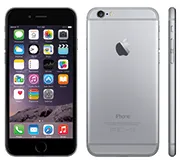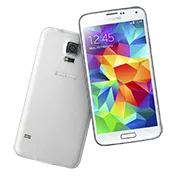Apple iPhone 6 vs. Samsung Galaxy S5
The iPhone 6 and Galaxy S5 are two of the best smartphones yet, but how do these flagships stack up head to head? See our 10-round battle.
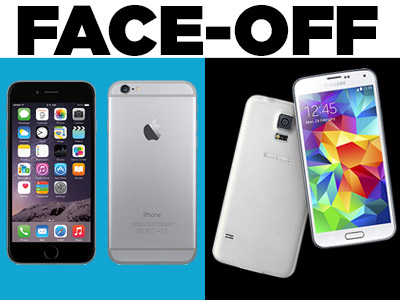
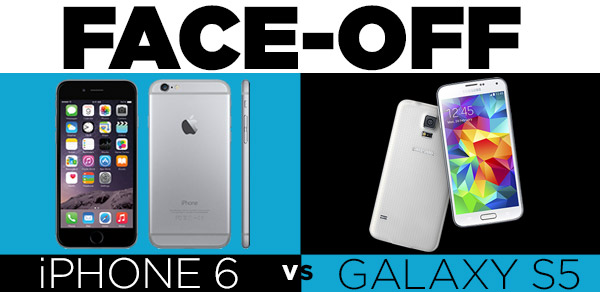
The battle between Apple's iPhone and Samsung's Galaxy has been raging for years, but the latest two flagship handsets put the companies more neck-and-neck than ever in 2014. Apple finally got the memo that consumers like bigger, 4.7-inch form factors, while Samsung took inspiration from the iPhone 5s to create the S5's fingerprint reader.
The iPhone 6 and Galaxy S5 are the most powerful and best-looking phones from their respective makers, but how do they stack up head to head? We put the two popular handsets through a 10-round gauntlet to find out.
Design
Do you like sexy or sporty? The iPhone 6 is Apple's slimmest, sleekest smartphone yet, with curved edges that make the handset's transition into the 4.7-inch arena a graceful one. The phone's aluminum back panel has a smooth, premium-feeling finish, which comes in Apple's usual trio of Silver, Space Gray and Gold color choices.
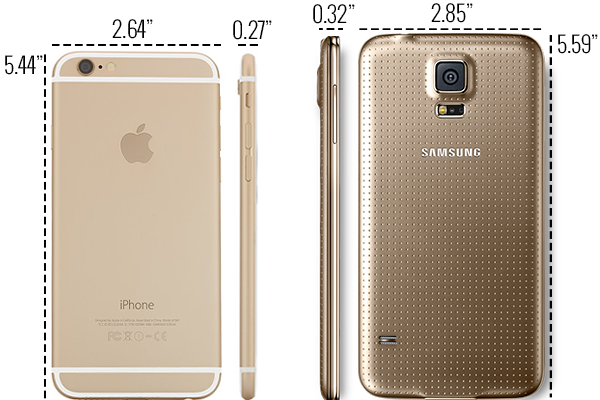
MORE: iPhone 6 Review and Samsung Galaxy S5 Review
The Galaxy S5's plastic design isn't quite as seamless, but it has some notable durability benefits. Sporting a glossy bezel and a soft, textured back panel, the IP67-rated Galaxy S5 can endure being dunked in 1 meter of water for 30 minutes. This water resistance comes with a caveat, though, as the flap that covers the S5's microUSB port is both pesky and flimsy.
Both phones are comfortable to hold, though the iPhone 6's lighter body and narrower design make it feel a bit more suited to one-handed use. At the same time, the iPhone 6's super-smooth edges and back panel made me feel like I could drop the phone at any moment, whereas I never had such a worry with the S5's more-textured body.
Winner: iPhone 6. While the Galaxy S5 is water resistant and easier to grip, the iPhone 6 has one of the slimmest, most premium-looking builds of any smartphone.
Get instant access to breaking news, the hottest reviews, great deals and helpful tips.
Display
The iPhone 6's 4.7-inch, 1334 x 750 display finally gives Apple fans a comparable screen size to the 5.1-inch Galaxy S5. But the new iPhone still lacks the full HD resolution (1920 x 1080) of Samsung's flagship.

Despite this difference in resolution, both phones pack some of the brightest and clearest smartphone displays in the business, with the iPhone 6 edging out the Galaxy S5 on our brightness test. If maximum real estate is your thing, the Galaxy S5's screen is noticeably bigger than that of the new iPhone, which is a plus when you're watching movies and browsing Web pages.
Both smartphones proved impressively sharp when I watched an episode of Arrow on Netflix, as I was able to see the finer details of Oliver Queen's prickly beard and deep-green leather jacket on either device.
The Galaxy S5 proved more color-accurate in our lab tests, scoring a Delta E rating of 0.9 (with 1 being most accurate). The iPhone 6 lagged behind, at 3.0.
Despite this, I found skin tones and clothing colors to look a little saturated on the Galaxy S5 and more natural on the iPhone 6 — a small difference, but one that was immediately noticeable when watching the episode side-by-side on both smartphones.
Winner: Galaxy S5. While the iPhone offers more-natural-looking hues, Samsung's flagship has the bigger display, and is the only one with full HD.
Audio
If you need a quick fix of music when showering or cooking dinner, the iPhone 6 and Galaxy S5 both do apt jobs filling small rooms with sound. The pulsing horns and sugary vocals of Taylor Swift's "Shake It Off" sounded crisp across the board, though the iPhone 6 sounded a bit louder and clearer when I quickly alternated between the two devices.
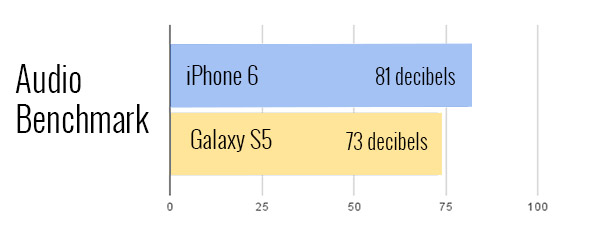
Listening to piano ballads like Sam Smith's "Stay with Me" was largely the same experience, with the iPhone 6 making it a bit easier to make out the layered vocal harmonies in the song's chorus.
The iPhone 6 also proved louder in our lab tests, with an 81-decibel output that trumps the Galaxy S5's showing of 73 decibels.
The Galaxy S5's speaker is located on the back panel, which makes the phone less than optimal for placing on a table and playing music. The iPhone 6's speaker rests along the bottom edge, so you won't have such a problem when you lay that device flat.
Winner: iPhone 6. The iPhone 6 offers louder and clearer sound.
Interface
The iPhone 6 comes loaded with iOS 8, which refines the minimalist design overhaul brought about by iOS 7. The Android-esque Control Center makes a return, featuring quick-access buttons for functions such as Wi-Fi, Bluetooth and Airplane Mode. And the OS' handy Spotlight search now searches the Web instead of just your device. Plus, the multitasking view lets you quickly dial your favorite contacts.
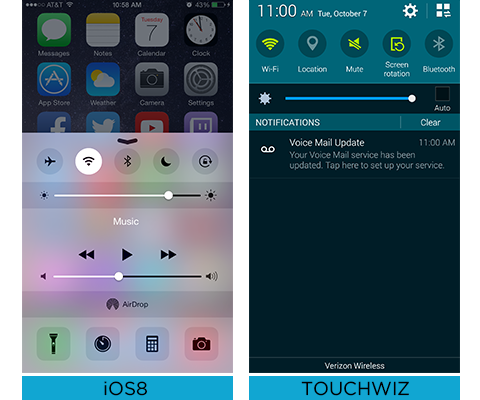
Apple has augmented its keyboard with a predictive text bar as well as the option for third-party keyboards, two features that Samsung Galaxy owners have been enjoying for years. However, unlike the iPhone 6, the S5's default keyboard includes a dedicated number row.
MORE: iOS 8 Review
The Galaxy S5 runs Android 4.4.2 coated in Samsung's signature TouchWiz skin, which makes app icons and menus look more vibrant than stock Android (despite some clutter). Like the iPhone 6, the S5 sports a slide-in menu for adjusting Wi-Fi and brightness, but the S5's menu has more options (like the ability to quickly toggle location services), and Quick Settings can be customized.
The Galaxy S5 has better widget support, allowing you to check the weather, search Google and shop Amazon all from your home screen. The iPhone 6 also allows for widgets, but only in the pull-down notifications menu. The S5 additionally benefits from Multi Window mode, which lets you split the screen between two apps.
Winner: Galaxy S5. While the iPhone 6's interface is clean and easy to navigate, the Galaxy S5's offers more functionality.
Special Features
The iPhone 6 and Galaxy S5 both gained some neat new features by doing a fair bit of borrowing from one another; the Galaxy S5 touts a Touch ID-esque fingerprint reader, while the iPhone 6 has adopted the NFC tech that has graced Android phones for years.
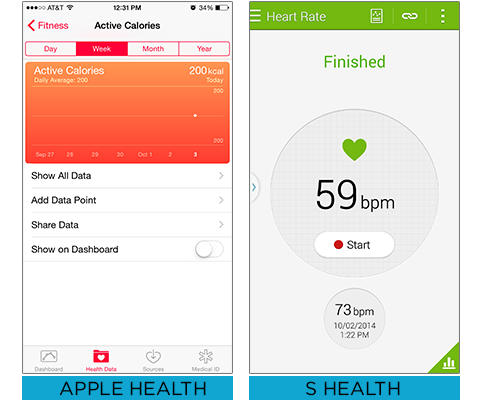
Located on the S5's home button, the fingerprint reader on this phone lets you register up to three digits for unlocking your phone, signing into your Samsung account and making PayPal payments. While this added layer of security is welcome, the S5's reader requires a vertical finger-swipe to unlock, which sometimes takes multiple attempts.
By comparison, the iPhone 6's Touch ID sensor allowed me to unlock the phone by simply placing my finger on the reader in any position. On top of unlocking the iPhone, Apple's fingerprint reader also allows you to instantly authorize iTunes purchases.
Soon, you'll be able to authorize instant mobile payments via Touch ID. The iPhone 6's new NFC capability is designed exclusively for Apple Pay, which will let you store payment cards to your iPhone's Passbook and make payments at supported registers with a quick tap of your device. Apple Pay will arrive for iPhone 6 owners by the end of October. Meanwhile, you can already make in-store payments with the Galaxy S5 at any location that supports the PayPal app.
The Galaxy S5's NFC capabilities go beyond mobile payments, as you can tap another NFC-enabled Android phone to instantly share Web links and contacts via Android Beam, or photos and documents via S Beam. You can also use NFC on the S5 to pair it with other devices, such as select Bluetooth speakers.
Both phones have apps built for the health conscious, but the Galaxy S5 has one big advantage in that department: a built-in heart rate monitor. Located under the smartphone's rear camera, the S5's sensor usually displayed my heart rate on the S Health app just a few seconds after I placed my pointer finger on the sensor. While the reader had difficulty registering my finger a few times, I appreciated being able to check my heart rate without an external accessory.
Winner: Galaxy S5. The iPhone 6 has the better fingerprint reader, but the Galaxy S5 has the more extensive feature set overall.
Camera
The Galaxy S5's 16-MP camera packs twice the pixels of the iPhone 6's 8-MP iSight sensor, but each phone's strengths and weaknesses go beyond mere megapixels.
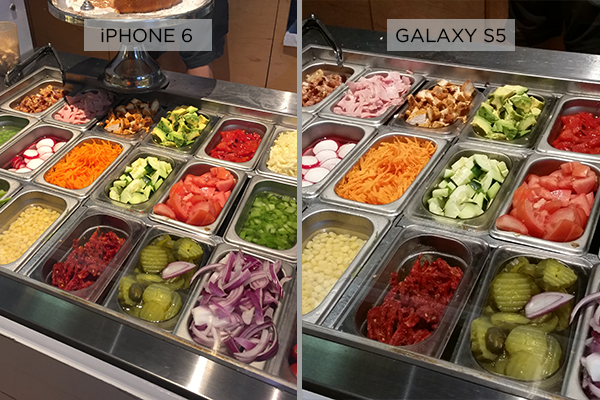
The majority of my shots looked more colorful and crisp on the iPhone 6, whether I was capturing a cafe's salad bar or an American flag flying against a concrete building.
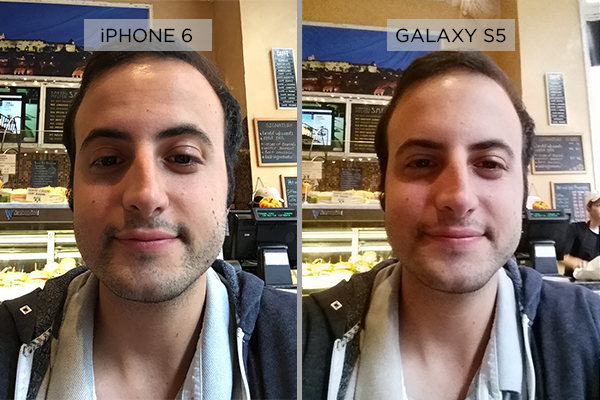
The Galaxy S5 didn't even come close on selfies, as its 2-MP front camera produced shots that were pale and grainy compared to those of the iPhone 6's FaceTime camera.
MORE: How to Take Better Photos with Your Galaxy S5
In a separate test, other editors noticed that the iPhone 6 has trouble setting white balance, but it's not an issue you'll likely notice in most of your shots.
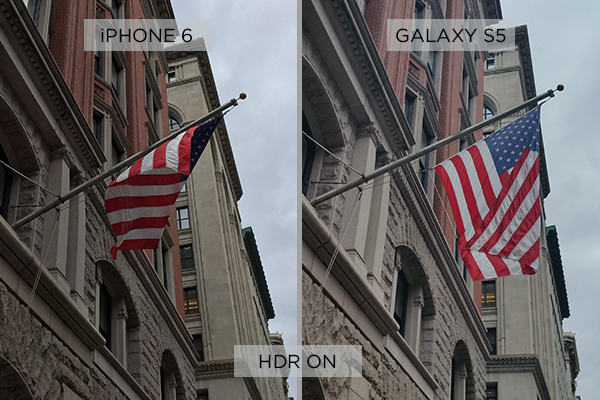
Both phones feature HDR, panorama mode, burst shots and slow-motion video. However, only the iPhone 6 supports burst shots in front-facing mode for rapid-fire selfies. I also noticed that the iPhone 6's near-instant autofocus is about a second faster than that of the S5.
MORE: The iPhone 6 Camera Has a Big Problem: iOS 8
When customizing your shots, however, the Galaxy S5 has the edge. Selective Focus lets you put the focus on either the background or foreground of a photo, while Shot and More mode lets you scrub away photobombers or create dramatic action shots.
Winner: iPhone 6. The iPhone 6's overall picture quality and zippy autofocus make it the better smartphone for shooting pictures.
Performance
Packing an Apple A8 and Qualcomm Snapdragon 801 processor, respectively, the iPhone 6 and Galaxy S5 are two of the zippiest smartphones around for playing games and bouncing among apps.
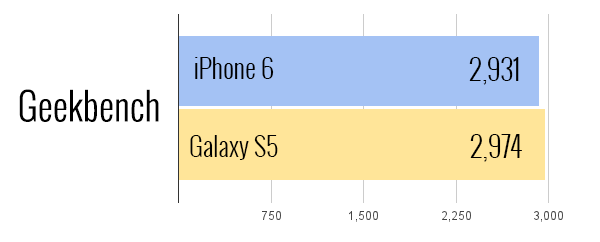
The Galaxy S5 has a slight edge in synthetic benchmarks, posting better scores in both the Geekbench 3 performance test and the 3DMark Ice Storm Unlimited graphics test. However, when loading hefty mobile shooter N.O.V.A 3, the iPhone 6's 5-second load time left the Galaxy S5 (19 seconds) in the dust.
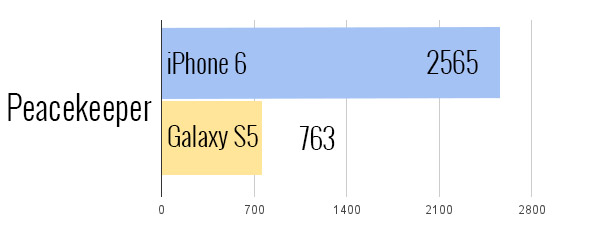
The iPhone 6 also excelled on the Peacekeeper test (which measures browser performance), trumping the Galaxy S5's score of 753 with a whopping 2,565. And while the S5 edged out Apple's phone on the 3DMark graphics test, the iPhone triumphed on the GFXBench Manhattan graphics test, nearly tripling Samsung's flagship, 31.6 to 11.7.
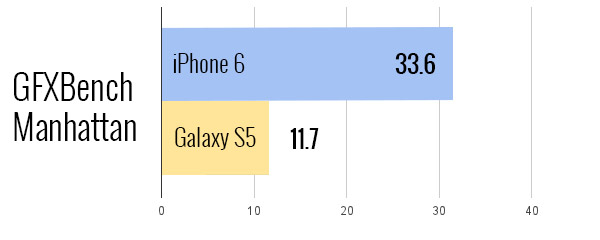
The Galaxy S5 was a bit faster than the iPhone 6 when running the Magisto video-editing app, which automatically applies edits and background music to a clip of your choice. Using the same clip, editing style and song, the Galaxy S5 cut up a 30-second video in 2 minutes and 5 seconds, while the iPhone 6 lagged behind at 2:35.
MORE: iPhone 6 Benchmarks: Here's How Good It Really Is
The iPhone 6 was quicker when launching the camera app from the lock screen. Apple's phone took about a second each time, while doing the same on the S5 usually took two or three seconds.
Winner: iPhone 6. Samsung's Galaxy S5 performed better in some benchmarks, but the iPhone 6 is quicker where it counts.
Battery Life
To test how long these two popular handsets will last you on a charge, we had them both surf the Web continuously over AT&T 4G LTE at 150 nits of brightness. The Galaxy S5 proved longer-lasting, at 9 hours and 42 minutes, trumping the iPhone 6's 7:40 battery life by over two hours.
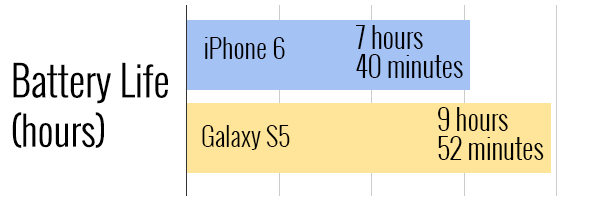
The Galaxy S5 also has an exclusive Ultra Power Savings Mode, which turns the screen grayscale, disables Wi-Fi and Bluetooth, and limits data use.
Winner: Galaxy S5. Samsung's smartphone lasts longer than the iPhone 6 and offers you more options for when you're low on juice.
Apps
The iPhone 6 packs a healthy (no pun intended) starting app selection, including newcomers like Health and Tips, as well as the entire iLife (GarageBand, iMovie) and iWork (Pages, Keynote, Numbers) app suites.
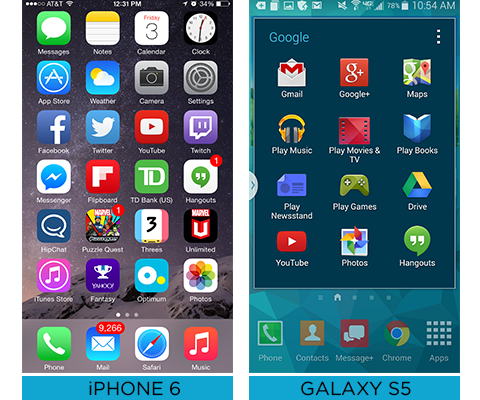
The Galaxy S5 ships with a standard smattering of Google Apps like YouTube and Maps, as well as Isis Mobile Wallet for making mobile payments. Samsung's phone is the only one of the two to sport a Kids Mode, which lets you create a child-friendly environment of colorful, simple apps while setting limits on what software can be used and for how long.
Apple's Health and Samsung's S Health both let you create detailed logs for your daily exercise and nutrition habits, though Health is more dependent on external apps and fitness trackers, while S Health allows you to quickly gather data via the S5's pedometer and heart rate monitor.
Apple's App Store catalog of over 1 million apps lags a bit behind the 1.3 million apps available on Google Play, but I prefer the cleaner interface and stronger game selection of Apple's marketplace. Still, aside from a handful of offerings like Infinity Blade and Facebook's Paper, most of the popular apps and games can be found on both stores.
Winner: Draw. Apple's App Store is a bit cleaner with some nice exclusives, but both phones have access to a wealth of great software.
Value
With a two-year contract, the iPhone 6 starts at $200 for 16GB of storage. Stepping up to 64GB will run you $300, and going for a gargantuan 128GB will cost a similarly huge $400.
Since it's a bit older, the 16GB Galaxy S5 can be found for as low as $100 (its suggested on-contract retail price is $200) with a two-year contract on Sprint, and you can expand its storage to up to 128GB with a microSD card.
Winner: Galaxy S5. With its expandable storage, you'll spend way less on a Galaxy S5 if you want maximum memory, although memory cards are better for photos and media than they are for apps.
Scorecard
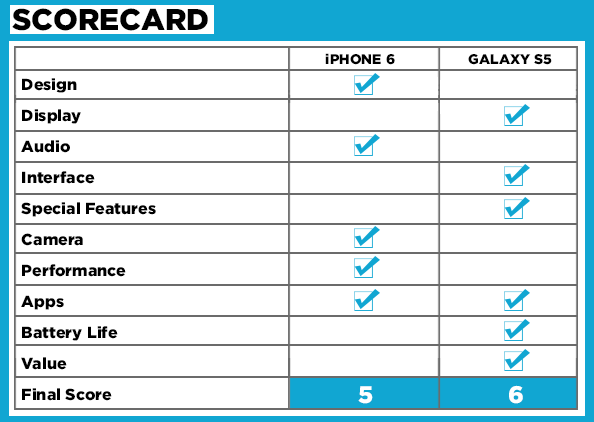
Apple's iPhone 6 is an excellent smartphone, but the Galaxy S5 still does some things better. Samsung's flagship is the only one of the two to sport a full HD display, water resistance and a heart rate monitor, and it packs expandable storage and better battery life to boot.
If you prefer Apple's app and content ecosystem, the iPhone 6's sleeker-than-ever design, higher-quality camera and speedy real-world performance make it a more than worthy upgrade. But if you're looking for the best overall package for your money, the Galaxy S5 has the slight edge.
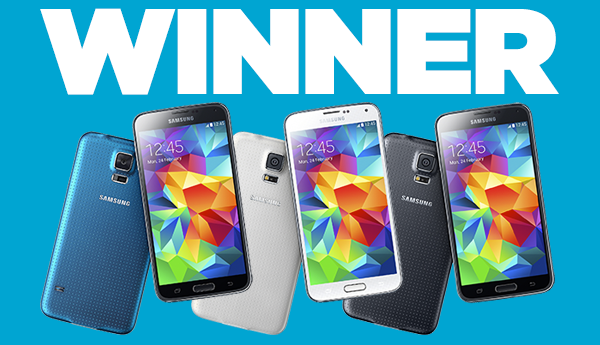
- Best Smartphones Available Now
- Galaxy S5 vs. Moto X: Smartphone Face-Off
- LG G3 vs. Galaxy S5: Smartphone Camera Face-Off
Mike Andronico is an Associate Editor at Tom's Guide. When he's not writing about games, PCs and iOS, you can usually catch him playing Street Fighter. Follow Mike @MikeAndronico. Follow us @TomsGuide, on Facebook and on Google+.
Mike Andronico is Senior Writer at CNNUnderscored. He was formerly Managing Editor at Tom's Guide, where he wrote extensively on gaming, as well as running the show on the news front. When not at work, you can usually catch him playing Street Fighter, devouring Twitch streams and trying to convince people that Hawkeye is the best Avenger.
